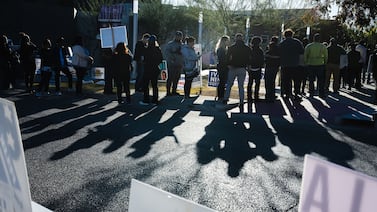Votebeat is a nonprofit news organization reporting on voting access and election administration across the U.S. Sign up for Votebeat Pennsylvania’s free newsletter here.
When Marryka Beck didn’t receive her mail ballot as expected ahead of the November 2024 election, the West Virginia University student knew she would have to drive back to Pennsylvania and vote provisionally on Election Day.
At her polling place in Washington County, Beck says she followed the staff’s instructions. She said that after she had finished marking her choices on the provisional ballot, poll workers told her to hand it back without placing the ballot in its secrecy envelope.
“They said they were going to fill out the envelope because they were unsure how to do it, so they were going to call the director,” she said in an interview with Votebeat and Spotlight PA. Then, two weeks later, “I got the letter that said my ballot wasn’t counted.”
Beck, 22, said her mother called the election office and was told the ballot was rejected because part of the section to be filled out by the poll worker hadn’t been completed, though Washington County officials told Votebeat and Spotlight PA it was because Beck hadn’t signed the envelope in one of the two required spots.
Provisional ballots are meant to be a fail-safe for voters, to be used when there are questions about eligibility or whether someone has already voted. They give election officials a chance to verify the ballot should be counted before they’re added to the tally.
But in Pennsylvania, that fail-safe is failing more often.
Between 2016 and 2024, the percentage of provisional ballots rejected due to technical errors on the outer envelope have increased from .95% to 4.92%.
In that time, the commonwealth added no-excuse mail voting, a major change that dramatically increased the number of mail ballots counties receive and led to a related increase in the use of provisional ballots.
But Pennsylvania election officials told Votebeat and Spotlight PA that this doesn’t entirely explain why a growing portion of provisional ballots are being rejected for exterior envelope errors. They say it may be a combination of inconsistent poll worker training from county to county, worker turnover, the complicated ballot envelope design, and the increase in use of provisional ballots leading to more opportunity for errors.
Whatever the issue, problems with these last-resort ballots are disenfranchising eligible voters like Beck.
“Not only did my mail-in ballot not come but then I had to drive home from school to vote for it to not even count,” Beck said. “The whole thing was just frustrating and annoying.”
More provisionals and way more rejections
More than 26,000 provisional ballots were cast in the 2016 presidential election, before the state had no-excuse mail voting, according to data tracked by the Pennsylvania Department of State. In the 2024 election, that number had nearly quadrupled, to almost 100,000.
There have always been a range of reasons why a voter might need to use a provisional ballot, even before no-excuse mail voting. A first-time in-person voter might lack identification, voters may not be registered when they think they are, or absentee voters might lose their ballots, among other reasons.
But no-excuse mail voting changed the system.
“We’ve had just a ballooning in the number of people who are voting provisionally, and that is because of the mail-in ballots,” said Thad Hall, elections director in Mercer County.
When voters receive a mail ballot and decide they don’t want to use it, or damage or make a mistake on it, they are allowed to bring that mail ballot to their regular polling place, surrender it, and then vote normally.
But if a voter doesn’t have their mail ballot, as in Beck’s case, they can’t surrender it. While some counties allow them to get a replacement, others don’t, and their only option is to vote provisionally.
The result is more provisionals. More than half of the provisional ballots cast in Chester County in November were related to mail ballots, said Karen Barsoum, the county’s elections director.
Like mail ballots, provisional ballots require voters to handwrite information on the exterior envelope. Mail ballots, for example, require voters to date and sign the envelope; failing to do one of those things properly can cause the ballot to be rejected. The date requirement is currently being challenged in court in multiple cases.
Provisional ballot envelopes have even more requirements, all of which could trip up an eligible voter. Voters have to sign the outer affidavit envelope in two separate places and write their address. Two poll workers have to sign and date the envelope and check a box with the reason the voter used a provisional ballot.
In the 2016 general election, a little under 1% of provisional voters had their ballots rejected for idavit envelope errors, a total of 251, but that percentage has risen steadily. By last November, that figure had increased to nearly 5% of all provisional ballots cast, or more than 4,800 ballots.
Election officials are considering a combination of factors that may have led to the increased rejections.
Chester County’s Barsoum said turnover in poll workers, as well as in the election officials who train them, is likely a factor. In a statement, a spokesperson for the Pennsylvania Department of State agreed turnover could be causing provisional ballot problems, but said the department did not want to speculate.
Because provisional ballots were less common before no-excuse mail voting, it’s possible some poll workers may be less familiar with how to guide voters through the process, as appeared to be the case for Beck.
“It seemed very unusual, like they didn’t know what was going on,” Beck said of her experience. The only other provisional ballot cast in her precinct was also rejected for envelope errors, according to county records.
Barsoum and Kathy Boockvar, the former secretary of the commonwealth who was in office when the mail voting law took effect, noted that Pennsylvania’s system of decentralized elections may contribute to the issue. While the law dictates how the provisional ballot process works, election officials and their solicitors in each of Pennsylvania’s 67 counties may reach different interpretations, Barsoum said. And while counties do conduct poll worker training, it isn’t necessarily uniform, Boockvar said.
Votebeat and Spotlight PA obtained poll worker training materials from roughly a third of the state’s counties, and there are discrepancies. For example, Delaware County tells its poll workers to have provisional voters fill out their information and sign section two of the envelope before voting, and then to have voters sign section 4 after marking their ballot choices. It tells poll workers to inspect the envelope “to ensure the voter has signed in sections 2 and 4 and properly completed the envelope.”
But Perry County’s manual makes no specific mention of having the voter sign either section, just that the judge should make sure the envelope is “completely filled out” and that the voter should place the ballot into a secrecy envelope, then the outer envelope, before handing it to the poll worker.
“Any incomplete idavit or anything missing from a form is 100% fixable from a standpoint of poll worker training and double checks,” Boockvar said. “Really no voter should ever be disenfranchised from a form when you are literally sitting there with someone filling that form.”
She said that other states require uniform poll worker training, and Pennsylvania should, too. Bills that proposed a standardized training requirement, among other election changes, were introduced in both the state House and the state Senate last legislative session, but stalled in committees.
The other question is whether there should be changes to the provisional ballot envelope, which is almost entirely designed by the state. Hall, of Mercer County, said it “isn’t super user-friendly.”
The places a voter needs to sign aren’t highlighted particularly well, he said, nor do they come with clear warnings telling the voter that failing to sign twice will result in rejection. Lacking a second signature is one of the most common reasons for rejection, Hall and other election officials said.
Voters are required to sign twice, because the first signature irms that their information is accurate and that they have not cast another ballot, and the second is signed after they vote the provisional to attest that they are eligible to cast a ballot. Hall has considered whether it is possible to combine the two signatures but said statute and case law prevent this.
Still, he said, some design changes could help, and counties have recommended that to the state.
The Department of State did not respond directly to a question about whether it was considering any changes to the provisional ballot envelope, but spokesman Matt Heckel, said it was “working with county partners to ensure that provisional ballots are as user-friendly for voters and poll workers as possible.”
Carter Walker is a reporter for Votebeat in partnership with Spotlight PA. Contact Carter at cwalker@votebeat.org.
Correction, April 11, 10:10 a.m.: A previous version of this story misstated the number of provisional ballots rejected for incomplete affidavit envelopes in the 2016 general election. It was 251, not 155.



